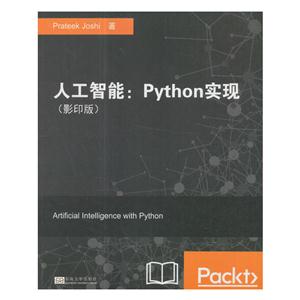扫一扫
关注中图网
官方微博
本类五星书更多>
-
>
全国计算机等级考试最新真考题库模拟考场及详解·二级MSOffice高级应用
-
>
决战行测5000题(言语理解与表达)
-
>
软件性能测试.分析与调优实践之路
-
>
第一行代码Android
-
>
C Primer Plus 第6版 中文版
-
>
深度学习
-
>
MATLAB计算机视觉与深度学习实战-赠在线交流卡和本书源码
人工智能:Python实现 版权信息
- ISBN:9787564173586
- 条形码:9787564173586 ; 978-7-5641-7358-6
- 装帧:一般胶版纸
- 册数:暂无
- 重量:暂无
- 所属分类:>
人工智能:Python实现 本书特色
随着大数据、人工智能时代的来临,Python已经成为很有发展潜质的机器语言。Python是一个高层次的结合了解释性、编译性、互动性和面向对象的脚本语言。Python的设计具有很强的可读性,相比其他语言经常使用英文关键字,其他语言的一些标点符号,它具有比其他语言更有特色语法结构。本书讲解相关知识。
人工智能:Python实现 内容简介
随着大数据、人工智能时代的来临,Python已经成为*有发展潜质的机器语言。Python是一个高层次的结合了解释性、编译性、互动性和面向对象的脚本语言。Python的设计具有很强的可读性,相比其他语言经常使用英文关键字,其他语言的一些标点符号,它具有比其他语言更有特色语法结构。本书讲解相关知识。
人工智能:Python实现 目录
PrefaceChapter 1: Introduction to Artificial Intelligence What is Artificial Intelligence
Why do we need to study AI
Applications of AI Branches of AI Defining intelligence using Turing Test Making machines think like humans Building rational agents General Problem Solver Solving a problem with GPS Building an intelligent agent Types of models Installing Python 3 Installing on Ubuntu Installing on Mac OS X Installing on Windows Installing packages Loading data SummaryChapter 2: Classification and Regression Using Supervised Learning Supervised versus unsupervised learning What is classification
Preprocessing data Binarization Mean removal Scaling Normalization Label encoding Logistic Regression classifier Naive Bayes classifier Confusion matrix Support Vector Machines Classifying income data using Support Vector Machines What is Regression
Building a single variable regressor Building a multivariable regressor Estimating housing prices using a Support Vector Regressor SummaryChapter 3: Predictive Analytics with Ensemble Learning What is Ensemble Learning
Building learning models with Ensemble Learning What are Decision Trees
Building a Decision Tree classifier What are Random Forests and Extremely Random Forests
Building Random Forest and Extremely Random Forest classifiers Estimating the confidence measure of the predictions Dealing with class imbalance Finding optimal training parameters using grid search Computing relative feature importance Predicting traffic using Extremely Random Forest regressor SummaryChapter 4: Detecting Patterns with Unsupervised Learning What is unsupervised learning
Clustering data with K-Means algorithm Estimating the number of clusters with Mean Shift algorithm Estimating the quality of clustering with silhouette scores What are Gaussian Mixture Models
Building a classifier based on Gaussian Mixture Models Finding subgroups in stock market using Affinity Propagation model Segmenting the market based on shopping patterns SummaryChapter 5: Building Recommender Systems Creating a training pipeline Extracting the nearest neighbors Building a K-Nearest Neighbors classifier Computing similarity scores Finding similar users using collaborative filtering Building a movie recommendation system SummaryChapter 6: Logic Programming What is logic programming
Understanding the building blocks of logic programming Solving problems using logic programming Installing Python packages Matching mathematical expressions Validating primes Parsing a family tree Analyzing geography Building a puzzle solver SummaryChapter 7: Heuristic Search Techniques What is heuristic search
Uninformed versus Informed search Constraint Satisfaction Problems Local search techniques Simulated Annealing Constructing a string using greedy search Solving a problem with constraints Solving the region-coloring problem Building an 8-puzzle solver Building a maze solver SummaryChapter 8: Genetic Algorithms Understanding evolutionary and genetic algorithms Fundamental concepts in genetic algorithms Generating a bit pattern with predefined parameters Visualizing the evolution Solving the symbol regression problem Building an intelligent robot controller SummaryChapter 9: Building Games With Artificial Intelligence Using search algorithms in games Combinatorial search Minimax algorithm Alpha-Beta pruning Negamax algorithm Installing easyAI library Ruildina a bot to olav Last Coin Standina Building a bot to play Tic-Tac-Toe Building two bots to play Connect FourTM against each other Building two bots to play Hexapawn against each other SummaryChapter 10: Natural Language Processing Introduction and installation of packages Tokenizing text data Converting words to their base forms using stemming Converting words to their base forms using lemmatization Dividing text data into chunks Extracting the frequency of terms using a Bag of Words model Building a category predictor Constructing a gender identifier Building a sentiment analyzer Topic modeling using Latent Dirichlet Allocation SummaryChapter 11: Probabilistic Reasoning for Sequential Data Understanding sequential data Handling time-series data with Pandas Slicing time-series data Operating on time-series data Extracting statistics from time-series data Generating data using Hidden Markov Models Identifying alphabet sequences with Conditional Random Fields Stock market analysis SummaryChapter 12: Building A Speech Recognizer Working with speech signals Visualizing audio signals Transforming audio signals to the frequency domain Generating audio signals Synthesizing tones to generate music Extracting speech features Recognizing spoken words SummaryChapter 13: Object Detection and Tracking Installing OpenCV Frame differencing Tracking objects using colorspaces Object tracking using background subtraction Building an interactive object tracker using the CAMShift algorithm Optical flow based tracking Face detection and tracking Using Haar cascades for object detection Using integral images for feature extraction Eye detection and tracking SummaryChapter 14: Artificial Neural Networks Introduction to artificial neural networks Building a neural network Training a neural network Building a Perceptron based classifier Constructing a single layer neural network Constructing a multilayer neural network Building a vector quantizer Analyzing sequential data using recurrent neural networks Visualizing characters i,! an Optical Character Recognition database Building an Optical Character Recognition engine SummaryChapter 15: Reinforcement Learning Understanding the premise Reinforcement learning versus supervised learning Real world examples of reinforcement learning Building blocks of reinforcement learning Creating an environment Building a learning agent SummaryChapter 16: Deep Learning with Convolutional Neural Networks What are Convolutional Neural Networks
Architecture of CNNs Types of layers in a CNN Building a perceptron-based linear regressor Building an image classifier using a single layer neural network Building an image classifier using a Convolutional Neural Network SummaryIndex
展开全部
书友推荐
- >
李白与唐代文化
李白与唐代文化
¥9.9¥29.8 - >
姑妈的宝刀
姑妈的宝刀
¥11.4¥30.0 - >
新文学天穹两巨星--鲁迅与胡适/红烛学术丛书(红烛学术丛书)
新文学天穹两巨星--鲁迅与胡适/红烛学术丛书(红烛学术丛书)
¥11.0¥23.0 - >
苦雨斋序跋文-周作人自编集
苦雨斋序跋文-周作人自编集
¥6.9¥16.0 - >
月亮与六便士
月亮与六便士
¥13.4¥42.0 - >
烟与镜
烟与镜
¥20.6¥48.0 - >
山海经
山海经
¥20.4¥68.0 - >
莉莉和章鱼
莉莉和章鱼
¥18.1¥42.0
本类畅销
-
深度学习自然语言处理实战
¥25.8¥59.9 -
过程控制
¥11.9¥35 -
2022图书×抽奖盲袋
¥9.9¥25 -
2023读书月阅读盲盒——天黑,闭眼,刀谁?
¥42.3¥158 -
2022读者节纪念徽章-三星会员专属
¥45¥45.6
















